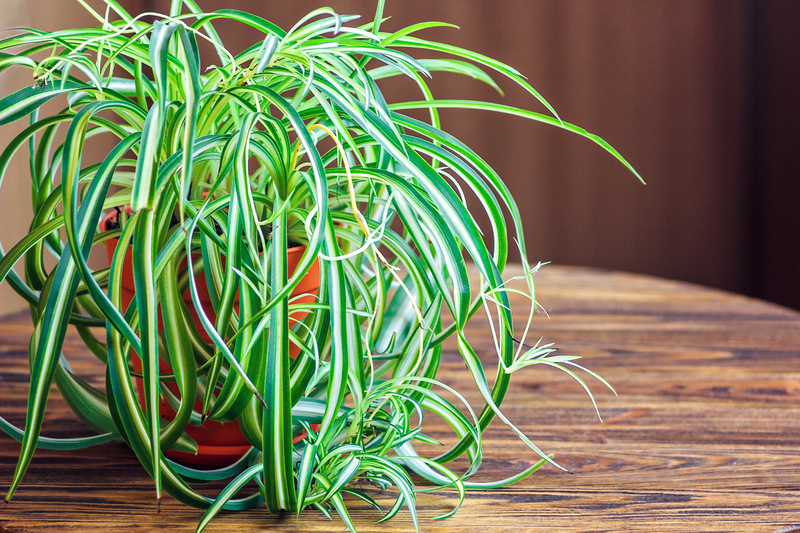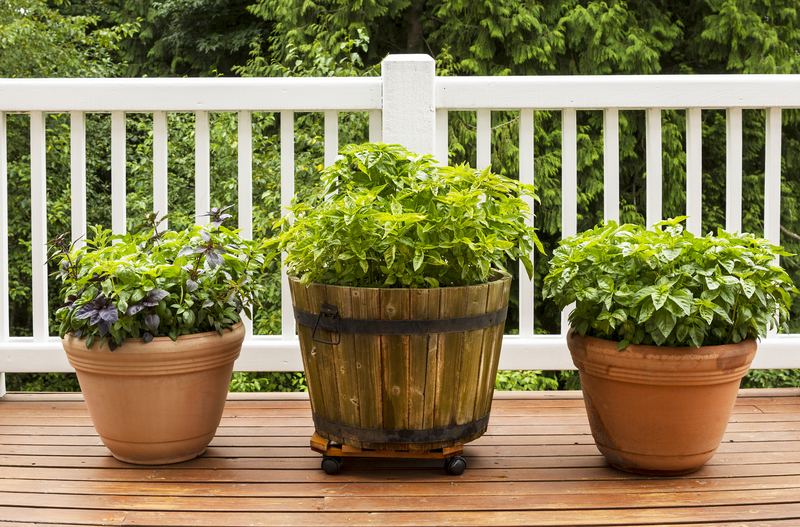Vertical Gardening: Elevating Home-grown Produce Cultivation
Posted on 04/09/2025
Vertical Gardening: Elevating Home-grown Produce Cultivation
Vertical gardening is not just a trend--it's a revolution in urban agriculture and sustainable living. With the growing interest in home-grown fruits, vegetables, and herbs, modern gardeners are turning to vertical solutions to maximize space, improve yields, and create stunning green interiors and exteriors. In this comprehensive guide, we will delve into the advantages, techniques, equipment, and tips for succeeding in growing your own fresh produce vertically.

What is Vertical Gardening?
Vertical gardening is a method of cultivating plants upwards using supports such as trellises, shelves, or walls instead of spreading them out horizontally. This innovative approach harnesses unused vertical spaces--balconies, fences, walls, or even indoor sections--making productive gardening accessible to those with limited ground space.
- Efficient Space Utilization: Grow more in less area.
- Improved Air Circulation: Reduces disease and promotes healthier plants.
- Decorative and Functional: Beautifies your space while providing fresh produce.
Why Choose Vertical Gardening for Home-grown Produce?
Vertical gardening offers a fresh perspective on home-grown produce cultivation. Whether you're an apartment-dweller or a homeowner with a small yard, going vertical means you can:
- Maximize Yield: Grow more types of plants in a smaller footprint.
- Reduce Pest & Disease Issues: Elevate produce above ground pests.
- Enhance Accessibility: Reduce bending and stooping, making gardening easier for all ages.
- Increase Sun Exposure: Plants receive more light when grown upwards.
Who Benefits Most from Vertical Produce Gardening?
Vertical produce gardening is especially beneficial for:
- Urban gardeners with limited outdoor space
- Landlords and renters looking to add greenery without altering property
- Disability-friendly garden design fans
- Anyone seeking to elevate their home's decor with lush, edible plants
Essential Elements of a Vertical Garden
Before diving into vertical gardening, it is vital to understand the building blocks of a successful vertical home garden. Consider these crucial components:
1. Support Structure
The backbone of your vertical gardening system is its structure. Options include:
- Trellises and Lattices: Perfect for vining crops like cucumbers and beans.
- Wall-mounted Planters: Modular, stackable systems ideal for indoor and outdoor use.
- Vertical Towers: Freestanding columns designed for hydroponic or soil growing.
- Pallet Gardens: Upcycle shipping pallets into productive produce walls.
2. Growing Medium
Choose between soil-based and soilless (hydroponic or aeroponic) media. Each has its advantages:
- Potting Mix: Lightweight, nutrient-rich blends are best for vertical containers.
- Coco Coir: Excellent moisture retention and root aeration.
- Hydroponics: Grows produce without soil, using nutrient solutions for rapid development.
3. Watering & Irrigation
Vertical gardens dry out faster than traditional gardens, so consistent and even watering is key. Opt for:
- Drip irrigation systems
- Self-watering planters
- Hand-watering with a long-spout can for small installations
4. Plant Selection
Not every plant is suited to vertical living. *Fruiting vegetables, herbs, and leafy greens* thrive in vertical setups. Some top choices include:
- Lettuce, spinach, and kale
- Strawberries
- Cherry tomatoes
- Cucumbers and pole beans
- Herbs like mint, basil, oregano, and parsley
- Peppers and small chillies
Setting Up a Vertical Garden for Home-grown Produce Cultivation
Choosing the Right Location
Analyze your space for the following factors:
- Sunlight: Most produce needs 6-8 hours of direct sunlight. South or southwest-facing walls are ideal.
- Access to Water: Proximity to a water source makes irrigation easier.
- Structural Stability: Ensure walls, fences, or railings can support the weight of wet soil and mature plants.
Building Your Structure
- Mount or position your chosen frames or supports.
- Install planters, planting pockets, or containers firmly onto supports.
- Fill planters with your selected growing medium.
- Add drip lines or self-watering reservoirs if desired.
Planting & Maintenance
- Sow seeds or transplant seedlings carefully to avoid damaging roots.
- Fertilize with a diluted liquid feed every 2-4 weeks.
- Prune and train vines upward for better airflow and sunlight exposure.
- Check daily for signs of drought, disease or pests.
Innovative Vertical Gardening Ideas for Any Space
- Pocket Planters: Use felt or fabric pockets to hang herbs along kitchen walls or outdoor fences.
- PVC Pipe Gardens: Drill holes in pipes to create tiered towers for lettuces or small vegetables.
- Recycled Bottle Walls: Upcycle plastic bottles by stacking them for a low-cost hydroponic system.
- Modular Plant Panels: Commercial living wall kits add both greenery and modern style to urban spaces.
- Hanging Basket Columns: Stack hanging baskets to create a lush, edible curtain of produce.
Benefits of Vertical Produce Gardening
1. Maximizing Limited Space
Even the smallest balcony, patio, or windowsill can become a productive vertical farm with the right setup, making fresh produce accessible to nearly everyone.
2. Enhanced Crop Health
Elevating plants improves airflow, reducing the chances of soil-borne diseases and minimizing slug and snail damage.
3. Urban Beautification and Air Quality
Vertical gardens double as natural air filters, boosting oxygen indoors and improving the aesthetic value of urban environments.
4. Simplified Maintenance
Reduces weeding, bending, and other strenuous gardening tasks while making harvests simpler to collect at eye level.
5. Year-Round Production
Many home gardeners use vertical systems indoors to produce leafy greens, herbs, and even dwarf fruit year-round with the help of grow lights.
Overcoming Challenges in Vertical Home-grown Produce Cultivation
Watering and Drainage Issues
Vertical gardens can dry quickly. To avoid water stress, use moisture-retentive substrates and mulch the soil surface. Install drip irrigation for reliable, controlled watering. Ensure containers have adequate drainage to prevent root rot.
Structural Considerations
Wet soil and mature plant weight can strain weak structures. Regularly check brackets and mounts. Distribute weight evenly, especially on balconies or older walls.
Pest & Disease Pressure
While vertical gardening reduces some pests, aphids, spider mites, and powdery mildew can still be problematic. Inspect plants often, use organic pest control, and remove diseased leaves promptly. Rotate crops each season to prevent the buildup of pests and diseases.
Best Crops for Vertical Gardens
While many plants thrive in vertical gardens, prioritize those that naturally grow upright, vine, or have shallow root systems.
Popular Vertical Garden Crops:
- Lettuce, spinach, and salad greens
- Strawberries
- Herbs--mint (in containers to prevent spreading), basil, parsley, thyme, oregano
- Cherry & grape tomatoes
- Cucumbers (pick smaller or bush varieties for best results)
- Peas and climbing beans
- Peppers and chilies
- Radishes and baby carrots (in deep enough pockets)
Pro tip: Plan crop rotation just like a traditional garden. After harvesting lettuce, for example, replant with herbs or baby spinach to maintain soil health and productivity.
Advanced Techniques: Hydroponic & Aquaponic Vertical Farming
Taking vertical gardening to the next level, hydroponics and aquaponics eliminate soil for a cleaner, faster, and more efficient produce-growing method.
Hydroponic Towers
Hydroponic vertical towers use a recirculating water and nutrient system to grow leafy greens and herbs rapidly. These require:
- Water pump and reservoir
- Soilless grow medium (perlite, coco coir, rockwool, etc.)
- Regular nutrient solution management
Aquaponic Walls
Aquaponic vertical gardening combines fish tanks with vertical grow beds, creating an integrated, eco-friendly food production cycle. Fish waste provides nutrients for plants, which in turn clean the water for the fish.
Troubleshooting Common Vertical Gardening Problems
- Dry Soil: Add water-retaining crystals or increase watering frequency.
- Drooping Plants: Check irrigation, root health, and support system stability.
- Poor Growth: Assess sunlight, swap for compatible plant varieties, supplement nutrients.
- Algae or Fungal Growth: Improve airflow, avoid overwatering, and use organic fungicides if needed.

Tips for Maximizing Vertical Home-grown Produce Yield
- Use High-Quality Seeds and Starts: Ensure strong germination and growth.
- Stagger Planting: Sow new crops every few weeks for continuous harvest.
- Regular Pruning: Direct plants upward, remove excess leaves, and encourage higher production.
- Fertilize Appropriately: Use a balanced liquid fertilizer for productive crops.
- Integrate Pollinator Plants: Attract beneficial insects for better fruit set.
Conclusion: Elevate Your Home Gardening Journey
Vertical gardening is transforming home-grown produce cultivation for the modern age. It makes gardening possible for city dwellers, enhances productivity on small plots, and brings vibrant life to walls, patios, and rooftops worldwide. By optimizing space, reducing pests, simplifying harvests, and beautifying homes, vertical gardening proves that anyone--with any amount of space--can cultivate their own fresh, delicious produce.
Embrace this elevated approach to sustainable living, and discover the joy of growing up--literally--with vertical gardens today!

